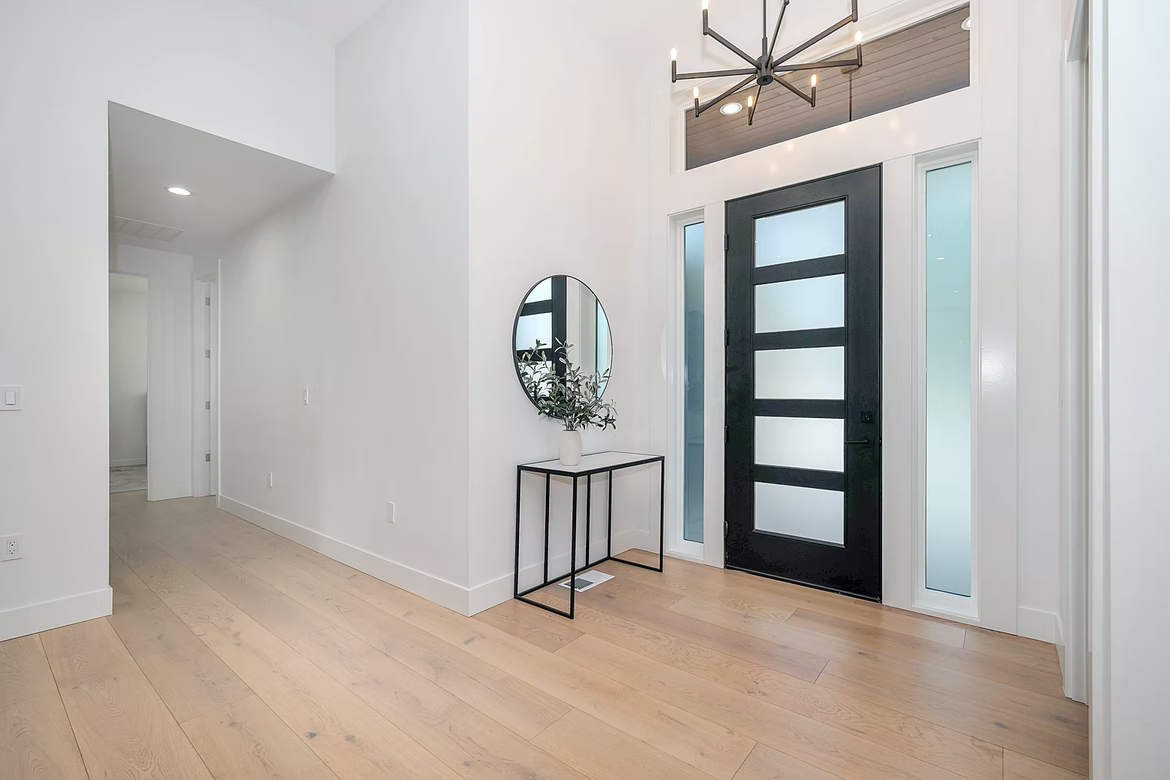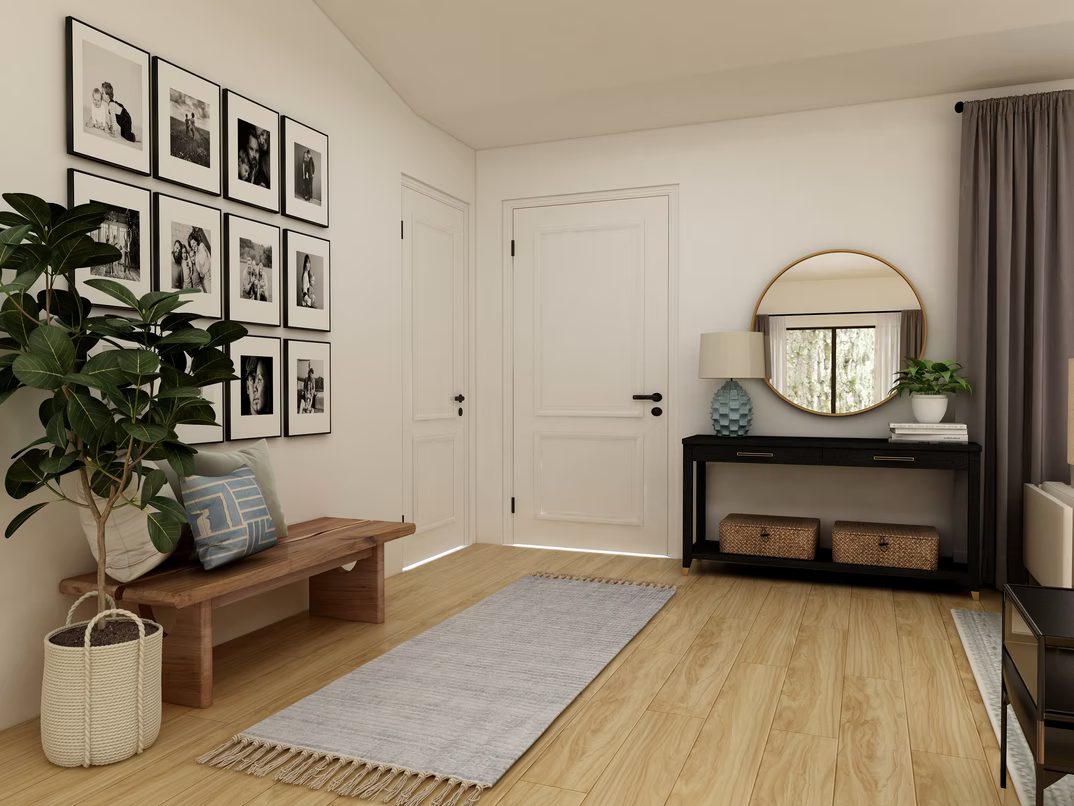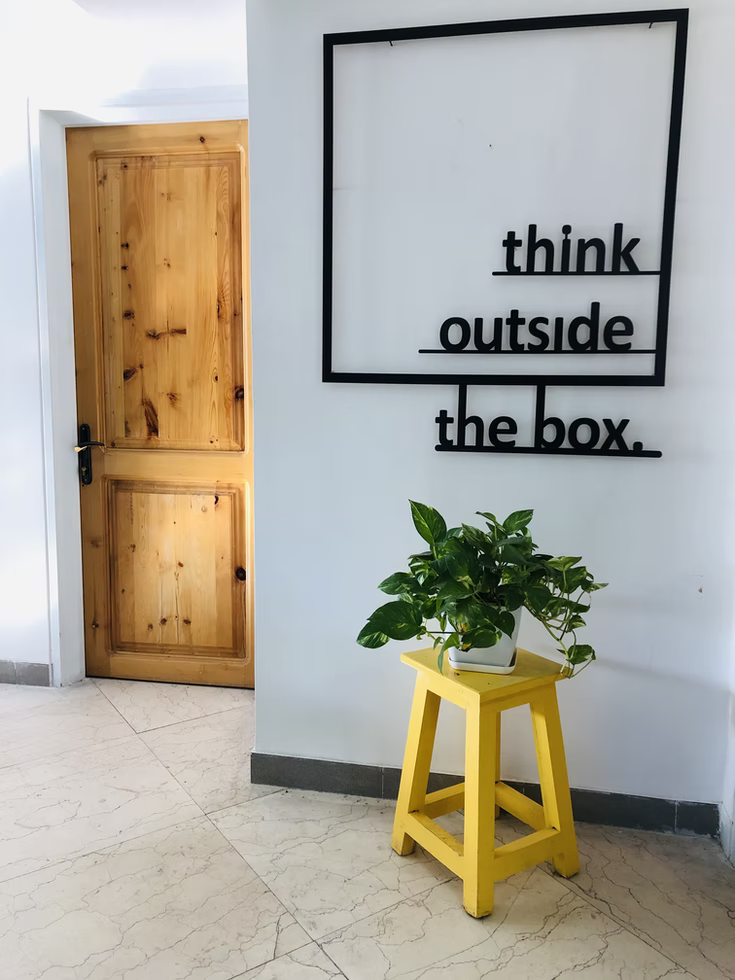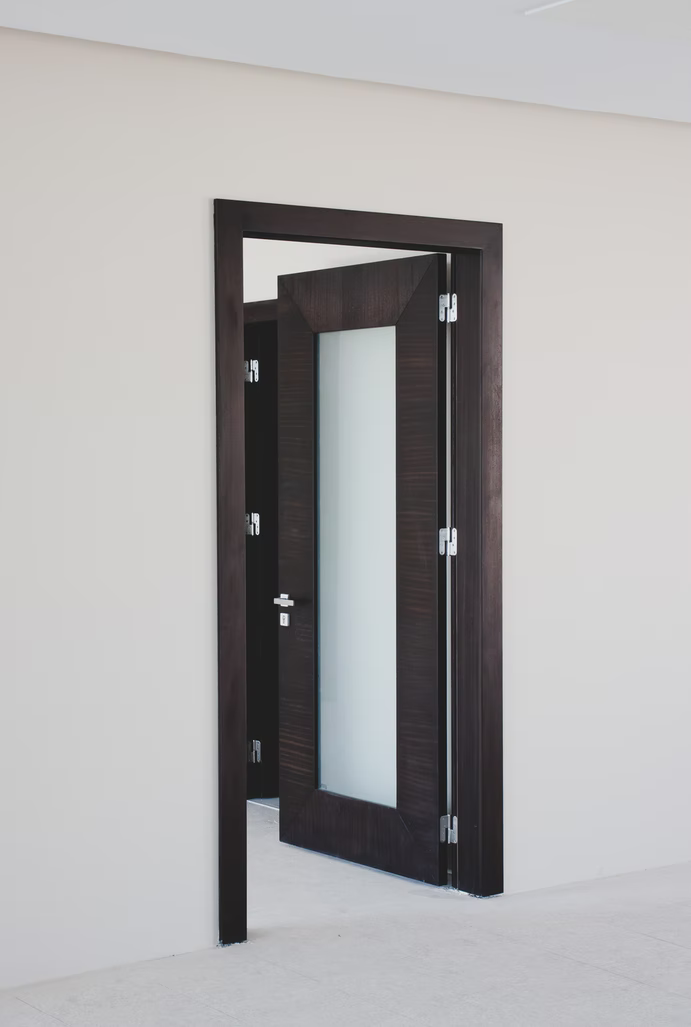The first thing we usually choose for a new interior is the flooring, walls, but also the interior doors. It is a good idea to prepare for the selection of these key elements before you browse the shops for furniture, to give you an idea of what you should be looking for. Let us talk you through what might seem like a simple choice, but is unfortunately often overlooked or the importance underestimated!
The First Step: Inspiration And Reference Examples Of Doors
The design of the door should match the style of the interior. Should your home be cosy, timeless, rustic, exotic, wild or, on the contrary, simple and elegant? Search online for photos of an interior you like and get inspired by the colour combinations. You do not just have to look at pictures of door manufacturers, but rather at the clever solutions of architects and designers. For example, you may find that designers suggest contrasting doors to distinctive furniture – often simple and monochromatic. In modern, bespoke interiors, they also choose doors that almost blend in with the surrounding wall. This can be achieved, for example, with an invisible (hidden) door frame.
Doors are rarely the dominant element, as their role is rather to repeat themselves and thus create a rhythm. However, the main door to a living room, for example, may be an exception. These can be distinguished from other terraced doors to bedrooms, bathrooms and so on.
Nowadays, architects mostly design plain doors that follow the simple style of modern furniture. You certainly will not go wrong by choosing a more plain door without unnecessary decoration. This makes the door match different styles of interior and makes it timeless.
You have to remember that you probably will not change their appearance every ten years like accessories and other interior furnishings. It will also be a good choice if the rooms in the apartment or house differ in style. This happens, for example, when each member of the family furnishes each room differently. While the furnishings in a small child’s room are likely to be cheerfully colored, a home office is more likely to be in white, grey or brown.
The Second Step: Matching To The Specific Interior
Outside influences will also play into your idea of interior design. The first will be that the choice of door should ideally match the exterior of the house. The form of the door cannot be completely separated from the form of the entrance door, windows, floors, stairs and railings and these in turn cannot be separated from the architectural expression of the building. In historic buildings, replicas of the original floors and doors will look best. For example, doors that span the full height of the room are suitable for airy new buildings.
The amount of light penetrating the interior is also an important parameter. Darker interiors with small windows and ceilings around 2.5 metres high are suitable for light colors. In bright interiors, you can also use very dark colors that look luxurious.
Tip: Try to imagine how the light will penetrate the room. Based on this, design door glazing or over-door skylights to help light up corridors or windowless areas.
For a tiny apartment, use a door with glazing to make the apartment feel bigger. A simple all-glass door will also look nice. Some types of glass are not transparent or translucent and can therefore be used in bathrooms and toilets without any problems.
Step Three: The Type Of Door For The Specific Room
In the third step, you need to be clear about the function of each room door. A list of the doors, usually in a table, should be part of the building project of the house or flat to help you find your way around the door design. If you are selecting all the doors at once, you need to think about unifying the appearance of the doors in all parts of the apartment or house. We recommend that you choose no more than two door types – solid and glazed. Clients most often want a solid door for their bedroom. However, you can also place a door with opaque glass in rooms where you require privacy.
Manufacturers support this desire to unify doors, and you can usually find solid and glazed doors in similar designs or decorations. A typical example is a framed door, which has only some of the frames solid or glazed. It is safe to say that these doors are timeless as they have been in use for over a century.
Fourth Step: Surface Specification
At the beginning of the selection process, you should opt for a door in a wood finish or a solid color door. To find the right door surface, visit two, three or more showrooms. In each showroom, you will see different examples of doors whose materials you can touch. Some suppliers focus on the cheapest surfaces (foils, laminates) and others are more likely to offer you mid to higher price points (veneered and painted doors). The highest price category is made up of vendors of doors that are not mass-produced. Doors with a higher proportion of solid wood are made by joinery manufacturers. This solution is not as expensive as it might seem at first.
Choosing a decor from an A4 or even smaller surface catalogue can be misleading. In particular, the pattern may appear more pronounced on the sample, because you perceive the small format differently than a surface of about 90x200cm. So it is ideal if you see the door in the decor you are ordering. If you don’t have the opportunity, apply your chosen decor vertically to the door and try to visualize the surface. Do not be afraid to bring a sample of your flooring or other material you have already chosen for the interior with you to the shop. Place a section of flooring on the ground in front of your chosen door. Unfortunately, lighting in stores is often misleading. We therefore recommend that you look at the samples in daylight.
Many people prefer wood decor when choosing their door and floor. However, matching a wooden floor and a wooden door is very difficult even for professionals. Choosing the same wood species for the floor and the door is rarely successful, and most commonly available flooring and veneer doors do not match. Doors adjoining the floor then do not look good. Count on the fact that wood on horizontal surfaces will always look lighter than vertical wood that doesn’t get as much light.
So you will not make a mistake if you choose a different color door to go with your wooden floor. It will look even better if at least one of the woods has a low-impact wood grain.
A solid-colored door with a wooden frame, a handle with a wood motif or even a door leaf decorated in a wood grain will also look good with a wooden floor.
If you insist on a single wood species, choose a solid wood floor and door with the same finish.
What we do not recommend is a combination of real wood and a low-credibility imitation (e.g. vinyl flooring or wood-look tiles). For these floors, choose a solid-coloured door instead. Imitation wood will look artificial and cheap in the presence of real material.
What Type Of Wood Should I Choose?
In addition to colour, we also recognise the grain – the natural texture of the wood. This can be very pronounced, but it can also be in the background. It depends on the type of wood, the surface finish and how the veneer is cut. Below are the most well-known woods according to color and grain that are used for the production of doors:
Light colors:
- Maple: this is one of the woods with a low-impact design. The color is very light and has an ivory to cream color. Thanks to its unobtrusive appearance, it will also go well with wooden floors.
- Birch: produces a very light veneer. Unlike maple, it tends to turn pink.
- Ash: is one of the lightest woods and will therefore look subtle and less pronounced. Imitations can be used with such light woods, which will not be as noticeable at first glance as they will be with darker shades.
- Spruce: a light wood used for solid doors. It has distinctive rings and knots, so it can look rustic. It is the cheapest wood and is therefore used for all carpentry, often also for windows and doors.
- Larch: a light pinkish wood with a denser structure of rings that gradually darkens. It is also popularly used for windows, facades, or internal stairs and panelling.
- Oak: has a warm and welcoming feel, so will provide a nice contrast to cold materials such as glass and metal. You can use it in interior design in large quantities – for furniture, flooring, etc. Oak is a very durable, hard and long lasting wood. Bleached oak is also popular and has a very light neutral color.
- Teak: a popular exotic wood for its warm color and interesting grain. With all of these exotic woods, you are more likely to see imitations than genuine veneers. Imitations of the same wood from different manufacturers differ quite significantly from each other.
Dark colors:
- Zebrano: the wood with the most distinctive grain. It was very popular some time ago and its appearance is almost extravagant.
- Walnut: one of the most beautiful woods valued for its beautiful grain and distinctive brown color. It has a light sapwood and a dark brown heartwood. American walnut is also popular.
- Wenge: always takes its place among the darkest shades, as its appearance transitions to black. Dust will unfortunately be more visible on shades this dark.
Brown to red:
- Cherry: the most famous red-brown wood. It clearly defines the colorful look of the interior. The interior in a combination of grey, black and white will fit nicely with redwood.
- Merbau: a very hard and durable wood with an exotic feel, it has a beautiful shade that only subtly transitions into red. Only natural veneer will look luxurious, not its imitation.
Solid-Colored Doors
Bright doors in white finished or ivory are the most popular. White doors are versatile and can be combined with any wall colour. Light tones of beige, coffee or grey will in turn look great on a white wall.
The cheapest finish is a foiled door, which can be plain, glazed or framed.
Depending on the character of the interior, you can choose matt or glossy doors. A high gloss finish will give an exclusive look, making the door unmissable. However, it is also the most expensive of the single-colour options on offer. Matte surfaces, on the other hand, will be easier to keep clean. They will give a more sober impression, which is suitable for cosy interiors. The matt will also contrast better with glass panels. For solid-coloured doors, you can choose to have the decor milled into the smooth surface of the leaf. This decoration is most often seen in the form of horizontal stripes.
Fifth Step: Exact Specification
Apart from the size, type and surface of the door leaf, you also need to choose other features. For glass panels, you have the option of specifying the lamination and type of glass. Of the glasses, we recommend clear and frosted glass – translucency as required.
For each surface, ask about the maintenance method and the load the door is designed for. Also, the method of glass replacement in case of breakage. Door fittings and hinges vary in shape, colour and, above all, quality. Never skimp on such details, because the quality of the detail determines the overall impression. The handle should fit your hand.
An important point in choosing a supplier will be to compare the services offered. If you are ordering a door for the whole house, you will be interested in the breadth of the range on offer – the possibility of different door openings, the extension of the opening with skylights, the variations of the door you have chosen for cold or damp rooms.
The price of the door includes:
- Preparation of the construction opening (or demolition of old door frames, removal of original doors and frames)
- Door leaf with hinges
- Door lock, cylinder lock or toilet lock
- Handle + rosette (cover plate)
- Frames
- Fitting of door frames, doors and hinge adjustment












